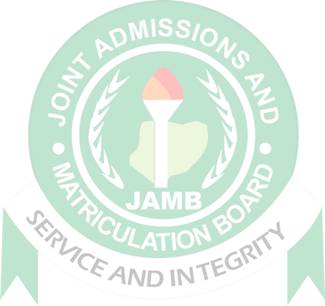
Mathematics (Core)
Paper 1 | Objectives | 48 Questions
JAMB Exam
Year: 1986
Level: SHS
Time:
Type: Question Paper
Answers provided
FREE
No description provided
Feedbacks
This paper is yet to be rated

Paper 1 | Objectives | 48 Questions
JAMB Exam
Year: 1986
Level: SHS
Time:
Type: Question Paper
Answers provided
No description provided
This paper is yet to be rated
Make sure you study hard but not into the late-night hours to give your body the enough rest you need.
Past questions are effective for revisions for all tests including WAEC, BECE, SAT, TOEFL, GCSE, IELTS
These are the best study techniques and methods that get higher grades in any school tests or exams.
| # | Question | Ans |
|---|---|---|
| 1. |
Evaluate (212)3 - (121)3 + (222)3 A. (313)3 B. (1000)3 C. (1020)3 D. (1222)3
Show Content
Detailed SolutionEvaluate (212)3 - (121)3 + (222)3(221)3+ (222)3 1211 121 ------ (1020)3 |
|
| 2. |
If Musa scored 75 in biology instead of 57, his average mark in four subjects would have been 60. What was his total mark? A. 282 B. 240 C. 222 D. 210
Show Content
Detailed SolutionLet x represent Musa's total mark when he scores 57 in biology and Let Y represent Musa's total mark when he now scored 75 in biology, if he scored 75 in biology his new total mark will be \(\frac{Y}{4}\) = 60, y = 4 x 60 = 240To get his total mark when he scored 57, subtract 57 from 75 to give 18, then subtract this 18 from the new total mark(ie. 240) = 240 - 18 = 222 |
|
| 3. |
Divide the L.C.M of 48, 64, and 80 by their H.C.F A. 20 B. 30 C. 48 D. 60
Show Content
Detailed Solution48 = 24 x 3, 64 = 26, 80 = 24 x 5L.C.M = 26 x 3 x 5 H.C.F = 24 \(\frac{2^6 \times 3 \times 5}{2^4}\) = 22 x 3 x 5 = 4 x 3 x 5 = 12 x 5 = 60 |
|
| 4. |
Find the smallest number by which 252 can be multiplied to obtain a perfect square A. 2 B. 3 C. 5 D. 7
Show Content
Detailed Solution\(252 = 2^{2} \times 3^{2} \times 7\)\(\therefore\) To make 252 a perfect square, the smalest number to multiply with = 7. \(252 \times 7 = 1764 = 42^{2}\) |
|
| 5. |
Find the reciprocal of \(\frac{\frac{2}{3}}{\frac{1}{2} + \frac{1}{3}}\) A. \(\frac{4}{5}\) B. \(\frac{5}{4}\) C. \(\frac{2}{5}\) D. \(\frac{6}{7}\)
Show Content
Detailed Solution\(\frac{2}{3}\) = \(\frac{2}{3}\)= \(\frac{2}{3}\) x \(\frac{6}{5}\) = \(\frac{4}{5}\) reciprocal of \(\frac{4}{5}\) = \(\frac{1}{\frac{4}{5}}\) = \(\frac{5}{4}\) |
|
| 6. |
Three boys shared some oranges. The first received \(\frac{1}{3}\) of the oranges, the second received \(\frac{2}{3}\) of the remainder. If the third boy received the remaining 12 oranges, how many oranges did they share? A. 60 B. 54 C. 48 D. 42
Show Content
Detailed Solutionlet x represent the total number of oranges shared, let the three boys be A, B and C respectively. A received \(\frac{1}{3}\) of x, Remainder = \(\frac{2}{3}\) of x . B received \(\frac{2}{3}\) of remainder (i.e.) \(\frac{2}{3}\) of x∴ C received \(\frac{2}{3}\) of remainder (\(\frac{2}{3}\) of x) = 12 \(\frac{1}{3}\) x \(\frac{2x}{3}\) = 12 2x = 108 x = 54 |
|
| 7. |
If P = 18, Q = 21, R = -6 and S = -4, Calculate \(\frac{(P- Q)^3 + S^2}{R^3}\) A. \(\frac{-11}{216}\) B. \(\frac{11}{216}\) C. \(\frac{-43}{116}\) D. \(\frac{43}{116}\)
Show Content
Detailed Solution\(\frac{(P- Q)^3 + S^2}{R^3}\) = \(\frac{(18 - 21)^3 + (-4)^2}{(-6)^3}\)= \(\frac{-27 + 16}{R^3}\) = \(\frac{-11}{-216}\) = \(\frac{11}{216}\) |
|
| 8. |
Simplify \(\frac{0.0324 \times 0.00064}{0.48 \times 0.012}\) A. 3.6 x 102 B. 3.6 x 10-2 C. 3.6 x 10-3 D. 3.6 x 10-4
Show Content
Detailed Solution\(\frac{0.0324 \times 0.00064}{0.48 \times 0.012}\) = \(\frac{324 \times 10^{-4} \times 10^{-5}}{48 x 10^{-2} x 12 x 10^{-3}}\)\(\frac{324 \times 64 \times 1 0^{-9}}{48 \times 12 \times 10^{-5}}\) = 36 x 10-4 = 3.6 x 10-3 |
|
| 9. |
Udoh deposited N150.00 in the bank. At the end of 5 years the simple interest on the principal was N55.00. At what rate per annum was the interest paid? A. 11% B. 7\(\frac{1}{3}\)% C. 5 D. 3\(\frac{1}{2}\)%
Show Content
Detailed SolutionS.I = \(\frac{PTR}{100}\)R = \(\frac{100}{PT}\) \(\frac{100 \times 50}{150 \times 6}\) = \(\frac{22}{3}\) = 7\(\frac{1}{3}\)% |
|
| 10. |
A number of pencils were shared out among Bisi, Sola and Tunde in the ratio of 2 : 3 : 5 respectively. If Bisi got 5, how many were share out? A. 15 B. 25 C. 30 D. 50
Show Content
Detailed SolutionLet x r3epresent total number of pencils sharedB : S : T = 2 + 3 + 5 = 10 2 : 3 : 5 = \(\frac{2}{10}\) x y = 5 2y =5 2y = 50 ∴ y = \(\frac{50}{2}\) = 25 |
Preview displays only 10 out of the 48 Questions